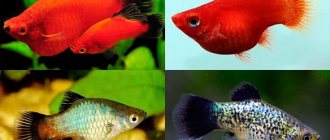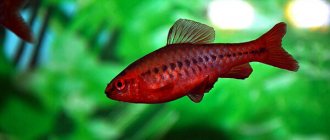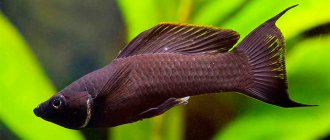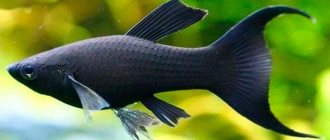One of the most common ornamental fish living in home aquariums are Swordtails, which belong to the order of viviparous fish.
Having an attractive appearance, relatively small size, unpretentiousness to living conditions, fertility and a friendly, cheerful disposition, they are extremely popular among aquarists.
And for those who are just starting out in the aquarium hobby, Swordbearer is an ideal option to learn how to properly handle aquarium fish and gain the necessary experience.
The main habitat of Swordtails, as well as the most likely place of their origin, is considered to be most of the countries of Central America. Also aquiferous areas of Guatemala and Honduras, washed by the Atlantic Ocean.
Swordtails are equally at home in mountain river gorges and in swampy reservoirs and lakes with stagnant water located throughout the entire Atlantic coast of Central America. Thanks to their increased ability to adapt to new living conditions, Swordtails have become widespread in most of the southern states of the United States and in some African countries.
Surprisingly, Swordtails can be found even in many open waters of some countries of the world, which are significantly removed from the tropics and subtropics, and do not have the necessary conditions for the survival of southern fish. Ichthyologists attribute this phenomenon to the fact that many aquarists, receiving an excess brood of fry from prolific Swordtails, release the offspring into the nearest reservoirs, in the hope of its high survival rate. And many Swordtails not only live up to these hopes, but also reproduce very well in extreme habitats. This is also facilitated by their rather long life expectancy for small fish - up to 5 years. During which, despite illnesses caused by lower water temperatures +16-18° C.
The first mentions of Swordtails kept in American aquariums date back to the mid-19th century. Almost at the same time, they were brought to Europe, and appeared in Russia only at the very beginning of the 20th century.
It must be said that the Swordtail, living in natural conditions, has mainly greenish or olive shades of color. The size of aquarium Swordtails is up to 11 cm. In the wild they can grow up to 13 cm.
Swordtails purchased in stores, thanks to breeding work, have a much greater color variety. In some, silvery-yellow colors, red, orange colors may predominate; there are even almost black and spotted individuals. Most often in pet stores they offer for purchase Swordtails with a predominance of red and orange tones of color.
But all varieties of the Swordtail are characterized by silver and an obligatory longitudinal stripe running from the head to the tail of the fish. The xiphoid caudal fin, from the unusual shape of which the name of these fish comes from, often has a dark border.
With proper maintenance and care of aquarium Swordtails, they will delight their owners throughout their lives - about 3-5 years.
Table of basic parameters of maintenance, care and nutrition:
| What should be the volume of the aquarium for the Swordtail? | from 10 liters for 1 individual |
| What should be the temperature in the aquarium for Swordtail | from +20-28 °C |
| What pH should be in the aquarium? | from 7-8 pH |
| What should be the hardness of the water in the aquarium? | from 9-25° dH |
| What should be the substrate for an aquarium? | any |
| What kind of lighting should be in the aquarium? | moderate |
| What should be the movement of water in the aquarium? | moderate |
| Maximum fish size | male up to 8-9 cm, female up to 10-11 cm in an aquarium |
| What does aquarium fish eat? | aquarium plants; dry food; live food: daphnia, tubifex, bloodworms |
| Type of aquarium fish | peaceful |
| Who is compatible with in an aquarium? | get along with all non-aggressive fish species |
| Lifespan | from 3-5 years |
Description
Swordtails can grow quite large. The male swordtail grows to a maximum total length of 14 centimeters, and the female up to 16 centimeters. But, usually in aquariums they are smaller, this very much depends on the species and conditions of detention. They live in an aquarium from 3 to 5 years.
The name "swordtail" comes from the elongated lower lobe of the male's caudal fin. Sexual dimorphism is moderate, the female is larger than the male, but lacks a “sword”. The wild form is olive green in color, with a red or brown lateral stripe and speckling on the dorsal and sometimes caudal fins. Captive breeding has produced many colored varieties, it is difficult to single out just one form, although the most popular would be the red with black tail.
And so they are red, green, black, albino, spotted, yellow. Describing them all is quite a difficult task.
But anyone who has ever seen an aquarium can imagine what a swordtail looks like. This fish is so common.
Care and maintenance
Like all inhabitants of the aquarium, the Swordtail, despite its unpretentiousness, requires the creation of optimal conditions. First of all, this is water with a temperature of +20-28° C (more comfortable +24° C), acidity of 7-8 pH and hardness of 9-25° dH. Some experts argue that water hardness should be from 9-25° dH will not cause discomfort to Swordtails.
The frequency of water renewal for these fish meets the general requirements for most aquarium inhabitants - 25-30% of the total water volume is changed once every 10 days. More frequent water renewal is undesirable for Swordtails; even two weeks in stagnant water, provided traditional aeration and water filtration are provided, will be comfortable for them.
One of the peculiarities of keeping Swordtails is that their increased motor activity and jumping ability require constantly keeping the aquarium under a special lid.
Also for the same reason, it is necessary to choose a larger aquarium, preferably an elongated one. Small cramped aquariums are unacceptable for Swordtails, since their active nature will inevitably lead to injury to the fish and fights among themselves.
The optimal aquarium volume for Swordtails is calculated based on 10-12 liters per adult.
Possible errors when determining gender
Despite the apparent simplicity of determining the sex of swordtails, in some cases an inexperienced aquarist may make a mistake:
- You should not try to determine the sex of these fish by color. Representatives of both sexes in this species are equally brightly colored; this applies to both artificially bred morphs and natural colors.
- In some morphs of swordtails (for example, lyretail), the shape of the caudal fin is modified, and it is impossible to determine their gender by the xiphoid process. In this case, you should focus only on the anal fin.
- It's easy to make mistakes when trying to determine the sex of fry. Characteristic external signs are fully formed only by 4 months of age; only from this moment can one confidently judge the gender of the fish. Sexual differences begin to appear from 2 months of age, however, fish identified as females during this period can be re-identified as males as they grow older.
- Swordtails are characterized by the phenomenon of gender inversion. Under certain conditions, females (even those who have given birth in the past) turn into males. First, their anal fin transforms into a gonopodium, and then a sword grows on the caudal fin. Such fish are able to mate with other females and produce offspring, but usually the offspring is weaker and fewer in number than from “normal” males.
Determining the gender of swordtails is a necessary task when keeping fish of this species. When trying to distinguish the sex of fish, one should rely on a set of characteristic external features; one cannot draw an unambiguous conclusion only from the presence or absence of a xiphoid process on the tail. You should also remember about sex inversion; this phenomenon is usually observed in old individuals or under unfavorable living conditions.
If you liked the article or have something to add, leave your comments.
What to feed Swordtails
To feed Swordtails, you need to combine plant and live food purchased at a pet store. Live or frozen food: bloodworms, tubifex, coretra mosquitoes or crustaceans of daphnia and cyclops.
Before feeding, frozen food must be thawed to room temperature.
If there is enough decorative vegetation in the aquarium, Swordtails can survive for a long time without additional frequent plant feeding, feeding on various algae that grow on plants.
Despite the ability of Swordtails to survive for up to 2 weeks without any feeding at all, to maintain good health the fish must still be provided with regular combined nutrition.
The ideal food for newly hatched Swordtail fry is a variety of live ciliates, microscopic rotifers, as well as traditional cyclops and daphnia, which can be purchased as fresh, clean aquarium plankton. Either turn live or frozen food into minced meat so that the food fits into the fry's mouth.
Habitat in nature
Swordfish (Xiphophorus helleri) is a freshwater species of the family Poeciliidae. Native to Central America from southern Mexico to Guatemala. X. hellerii has become a nuisance pest as an introduced species in a number of countries. It has caused environmental damage due to its ability to multiply quickly in large numbers. Wild populations have become established in southern Africa, including Natal, Hawaii, Madagascar and Eastern Transvaal in South Africa, and Lake Otjikoto in Namibia.
They live in nature in various reservoirs, both with running and standing water. The swordtail prefers fast-flowing, densely vegetated rivers and streams, but is also found in warm springs and canals. An omnivore, it feeds on both plants and small crustaceans, insects and annelids.
They prefer shallow, abundantly overgrown places where they feed on various insects, algae and detritus.
The difference between a female and a male
Males and females of the Swordtail are easily distinguishable. The females of this fish always have a paler color, but are almost always larger than the males. Males - on average up to 8-9 cm, and females can reach up to 10-11 cm.
The main sexual characteristic of the male Swordtail is the elongated shape of the anal fin, called the gonopodium. This organ is the reproductive organ of most male viviparous fish. The anal fin of females is triangular or fan-shaped.
But this sexual characteristic should be considered secondary. The female Swordtail, under certain conditions, can transform this fin into a “sword”. Changing one's gender is common to some fish species. Ichthyologists call this “phenotypic sex change.”
Why do you need to know your gender?
Accurate determination of the sex of swordtails is required when selecting specimens for group keeping. It is recommended to keep fish of this species in a flock of 5 or more pieces, and the ratio of males and females in it should be 1:2 or 1:3. With fewer females, regular fights will occur between males, often resulting in injuries.
In addition, it is necessary to correctly determine the sex of swordtails if the aquarist intends to breed this species. If the group for keeping together consists of only females, separated from males at an early age, there is no need to worry about the appearance of unwanted offspring. This is important when breeding pure lines, when male and female representatives of different morphs are kept separately from each other and are brought together only for mating.
Reproduction of Swordtails in an aquarium
Swordtails belong to the viviparous order of aquarium fish, the Poecoliidae family. This means that the formation of fry occurs inside the female. Newly born fry have all the characteristic features of adults, with the exception of fins, which are finally formed much later.
Reproduction of Swordtails occurs naturally, in a normal favorable aquarium environment. Fertilization by the male of the female occurs with the help of the anal fin “gonopodium”, which has the shape of a tube. Through the anal fin “gonopodium”, the male injects seed into the inside of the female’s abdomen.
The fry mature within 6 weeks. The number of fry born can range from one and a half dozen to hundreds of individuals.
It is recommended to place a pregnant female, ready to give birth, in a special separate aquarium “pilot”. After the fry are born, the female must be returned to the community aquarium. The fry remain in the hatchery until their size is below 3-4 centimeters (after 2-3 months), after which they can be placed in a community aquarium.
Pregnancy and childbirth
Several signs help determine pregnancy. So, first of all, the stomach testifies to this. In a pregnant woman it is round and large. The transition from the front part of the body to the abdomen is pronounced (step-like). As a result, the fish's head looks small and graceful, unlike other, non-pregnant fish.
Near the anal fin of the female, a dark-colored spot begins to be visible, indicating that the fry are gestating. It darkens over time and increases in proportion to the stages of development of the offspring. Before childbirth, the abdomen takes on a rectangular shape, and a protrusion forms near the cloaca.
A pregnant female swordtail acquires an impressive size before giving birth!
Swordtails bear their offspring in a common aquarium. Pregnancy in females lasts from 4 to 6 weeks. Depends on a number of conditions:
- parameters of the aquatic environment, temperature;
- the degree of illumination of the aquarium, or the duration of daylight hours;
- food ration, its quality;
- age and health status.
Before giving birth, the fish's behavior changes. She rushes around the aquarium and becomes restless. She loses her appetite. If there is vegetation, the expectant mother tries to hide in it. If there are no plants, it stays near the bottom, hiding behind the decorations. Or it hides in the corner of the aquarium, in places where neighbors cannot disturb it.
If these signs are established, then the pregnant fish should be immediately transplanted into the spawning tank. This must be done so that the fry that are born do not become food for other inhabitants of the aquarium.
Some breeders use the fibers of a synthetic washcloth for the spawning tank, in which the fry will hide from their hungry mother.
Usually the spawning tank is a small aquarium, from 10 to 20 liters. After birth, the fry will be raised in it. Before transplanting the female into this tank, it should be filled with water from the previous habitat of the woman in labor. This is necessary to eliminate the stressful state of the pregnant female. It is recommended to place floating vegetation in the spawning tank. Subsequently, the newly born fry will hide in it.
06:56
How does a swordtail give birth?
Practice shows that in viviparous female swordtails, spawning occurs in the morning; this process lasts from several hours to a day. In this case, 50 - 200 babies may appear. The fish give birth to one fry after approximately equal periods of time. Once born, swordtails tend to the surface and seek shelter in plants, or sink to the bottom.
After the end of the birth, the female should be resettled back into the general aquarium. This must be done so that she does not destroy or eat her offspring.
Compatibility with other fish
The swordtail, being a peace-loving aquarium fish, gets along without problems with almost all small, non-hostile fish. The best neighbors of the Swordtail in the aquarium are its closest “relatives” from the Poeciliaceae family - almost all species of Plaeciliidae and Mollies, ray-finned fish Barbus and Danio, as well as Minors and Tetras of the Characin family.
Keeping Swordtails with almost all types of large Cichlids that have a particularly aggressive disposition is contraindicated. Also with most fish of the macropod family - Cockerels, Macropods, Laliuses, and other slow fish, which Swordtails, being very mobile, can damage their luxurious veil fins.
brief information
The first mentions of swordtails date back to 1864. Over 160 years of development of aquarium keeping as a science, fish are recognized all over the world. It is rare to find an aquarium in which there are not several fish swimming that have an unusual shape of the caudal fin structure. The Russian name Xiphophorus hellerii appeared due to the translation of a pair of Greek words xiphos - sword, phoros - to carry.
The natural version of the fish has rather modest colors in its coloration. As a rule, swordtails living in nature have yellow or brown-green primary colors. Thanks to crossing with the common platie, breeders managed to obtain a lot of hybrid forms that differ in color.
The classic version of the swordtail, familiar to many aquarists, is a fish whose main color is red, with a black tail and an elongated lower ray of the caudal fin. Today there are many variations of the fish, differing in color, body shape and the number of elongated rays of the caudal fin. Females of Xiphophorus hellerii have one interesting feature - they can change sex to the opposite depending on conditions.
Swordtail fish - species
In fact, Swordtails can be divided into two types - natural and aquarium.
The aquarium species has many varieties bred by breeders. The names of those bred by selection are associated, first of all, with the peculiarities of coloration, size and shape of the fins.
The natural species of Swordtails is classified by experts more definitely and has about a dozen varieties. All of them have a predominant greenish color and, as a rule, are not kept in home aquariums.
Feeding forked swordtails
Forked swordtails are unpretentious eaters. Any type of food is suitable for them:
- dry sticks, granules, flakes, etc.;
- live and frozen bloodworms, coretra, daphnia, aulophorus, tubifex, brine shrimp;
- balanced ready-made feed Tetra Min;
- finely chopped egg yolks, boiled fish, crackers.
Tetra Min balanced ready-made food is suitable for swordtails.
Swordtails are able to collect food from the surface, find it in the water column and at the bottom. They eat algae with pleasure. The plant components of the food can be prepared by chopping nettles, lettuce or spinach previously scalded with boiling water.
You need to feed once a day. From time to time it is necessary to arrange fasting days.
Diseases of Swordtails: external signs and treatment
Almost all diseases of Swordtails are associated with violation of the basic rules of keeping and caring for them.
Fin rot
Occurs as a result of damage by pathogenic bacteria. It is manifested by the formation of a gray narrow rim on the fins, which darkens over time and covers the entire fin, right up to the body of the fish. If timely treatment measures are not taken, Swordtails lose the ability to swim, and their nervous system is irreversibly damaged.
In order to treat this disease, the fins of the Swordtail are usually treated with disinfectant Methylene blue for aquarium fish, which can be purchased at pet stores, and the sick fish are placed in a separate aquarium for quarantine.
When the symptoms of the disease disappear, after 3-5 days the fish can be returned to the general aquarium.
Chylodonellosis
The disease is of parasitic origin. It is manifested by loss of appetite in fish, pressing of the dorsal fin to the fish ridge and the appearance of a gray-blue coating under the fin.
In this case, the affected areas are treated with antiprotozoal drugs, for example, Tripaflavin. Quarantine keeping of fish is mandatory.
Ichthyophthiriasis
The cause of the disease is the equiciliated ciliate. It is manifested by the formation of small white tubercles on the body of the fish.
There is no effective drug to treat this disease. Experimentally tested quarantine conditions are used. Raising the water temperature to the maximum +35° C and adding a little salt, the universal aquarium product “Malachite Green” and Furazolidone to the water.
Mycobacteriosis
The disease is fungal in nature. The fish lose their appetite and become indifferent to the environment; over time, they lose the ability to swim and maintain a balanced position. The progressive disease leads to the formation of ulcers and abscesses on the body of the fish.
The development of the disease is rapid and can only be treated at an early stage. Tripoflavin and/or Monocycline are usually used for treatment.
Raising fry
Swordtails are unpretentious inhabitants of the aquarium. They adapt well to any environment and can survive in difficult conditions. However, this applies to strong and healthy offspring.
From birth, swordtail fry copy the coloring of their parents, but fully reveal their beauty by 4 months.
In the first days after the young animals are born, optimal conditions should be created for them. Provide lighting even at night. Feed more than 4 times a day. When reaching 3 months of age, switch to 3 meals a day.
The main diet of swordtail fry is:
- chicken egg yolk (boiled and pureed);
- crushed flakes, fish feed;
- spirulina;
- Artemia nauplii.
If you alternately feed spirulina and live food, the swordtails will acquire a bright color and their growth will occur faster.
The food must contain sufficient fiber. This is necessary in order to bring the diet closer to natural conditions. In nature, swordtails eat mainly plant foods.
Egg yolk should be used in moderation; it is a good base for bacteria and strongly pollutes water. If the water becomes of poor quality, the fry do not live long. Frequent, abundant water changes will also lead to the death of the offspring of swordtails - this causes severe stress in them, leading to their death.
Decide in advance where you will put the fry when they grow up, because the spawning ground will soon become too small for them!
You also need to pay attention to the fact that the younger generation had enough space left in the family aquarium. Sometimes, as the fry grow, they need to be moved to larger containers. Otherwise, they will grow weakened with various defects.
You can transplant young fish into a common aquarium when they reach a size at which they will not become food for other fish. Under normal conditions of keeping the fry, this time comes after 3 - 4 months.











